
Wildflower diary
Blackthorn prunus spinosa
Spring 2024
Spring has clearly now arrived in Shamley Green: on a short walk around the village on a bright afternoon in February we photographed all the flowers on this page!
There were spectacular drifts of crocus blooms opening widely in the sunshine, such a welcome sight. Some of our crocus are planted, but many are not: the early-flowering species Crocus tommasinianus does really well here and appears to be spreading by seed and offsets to lots of unexpected places alongside footpaths and under trees. It's native to hillsides and woodland areas from southern Hungary into the northern Balkans and was introduced to the UK in the late 19th century.
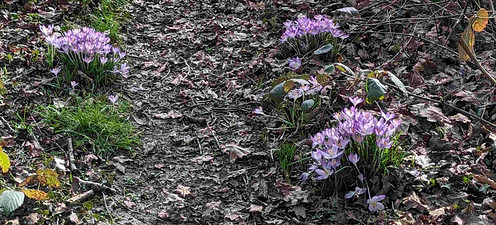

Daffodils with a lovely Crocus backdrop on Easteds Green - these are the later-flowering Crocus vernus
Crocus tommasinianus naturalised by a footpath at Lords Hill
Daffodils (Narcissus species) have been in the UK much longer, brought here by the Romans. They are found in a variety of habitats in Europe and North Africa, ranging from sea level to subalpine meadows, woodlands and rocky places. Spain hosts the greatest variety of species, but they can also be found in Morocco, Portugal, western France, Italy, and other countries.
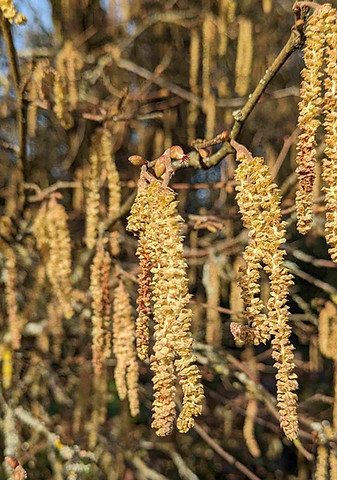
Hazel catkins - another early spring delight

Female flower of the hazel - more difficult to spot than the showy male catkins

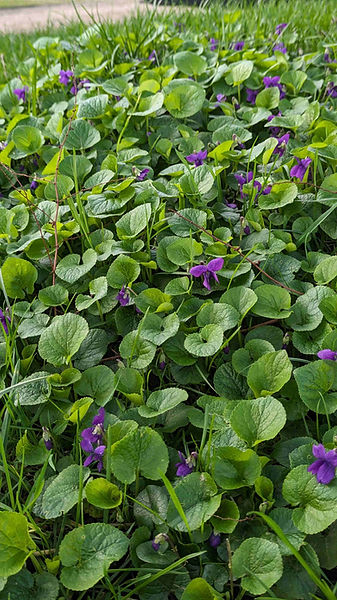
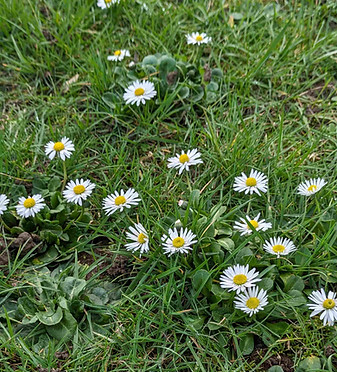
The daisy (or 'day's eye') follows the sun as it crosses the sky, and closes at night
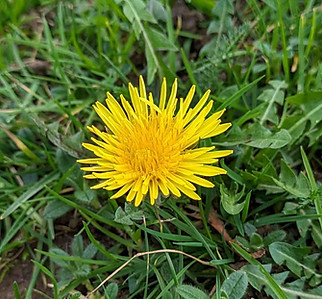
Dandelions track the sun too, a process called 'heliotropism' - it keeps the flowers warmer for pollinating insects
The early scented flowers of the sweet violet, Viola odorata, are pollinated by bees, hoverflies and bee-flies
Interestingly, you are unlikely to see sweet violet flowers from May to September, but they are still there - it's just that they are close to the ground and don't open, but set seed by self-pollination instead, and it has been found that the majority of seed is produced this way! This seems like a strange thing to do in the summer, when there must be many more insects around to carry out cross-pollination, but it may be a water-conserving adaptation. Later on in the year the plants will start producing a few open flowers again!
Lots more information in this fascinating article https://awkwardbotany.com/2020/07/08/the-hidden-flowers-of-viola/

Non-opening Viola flower hiding near the ground, this photo taken in April

Shepherd's purse Capsella bursa-pastoris with a visiting hoverfly, and distinctive seed pods developing lower down
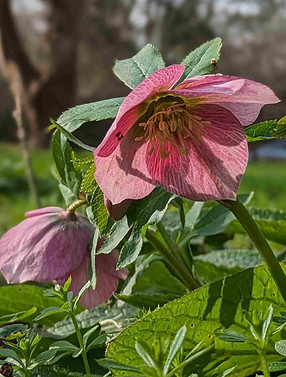
This lovely hellebore on Spring Cottage Green is probably a garden escape, doing very nicely in the wild
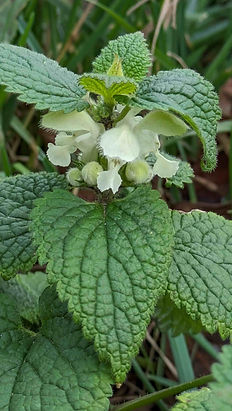
White deadnettle Lamium album
with nettle-like leaves but no sting!

Lesser celandine
Ficaria verna
a very early-flowering relative of buttercups

Lungwort
Pulmonaria officinalis
with distinctive spotty leaves

Cyclamen hederifolium
flowers appear in spring at the same time as the ivy-like leaves
We found a few primroses in flower in February and there will be many more to come in the weeks ahead - last year they were still flowering prolifically in May.
During the 1960s and through to the 1980s a paper mill in Devon began sending bunches of primroses to all of its clients throughout Britain accompanied by an attractive card to promote their paper products - on one record-breaking day over 18000 bunches (yes, 18000!) were picked for them by local schoolchildren who were paid 4d a bunch! This was a massive expansion of the practice of an earlier mill owner sending primroses to a few clients since the early 1900s, and unsurprisingly by the late 80s it was raising environmental concerns and was abolished!
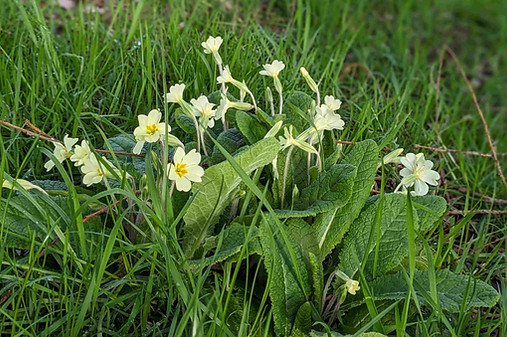
Primrose Primula vulgaris growing on Lords Hill Common



Promotional primrose cards which became collectors' items!
Hairy Bittercress Cardamine hirsuta flowering early in the shelter of a fence
Red deadnettle Lamium purpureum, a common annual weed of waste ground
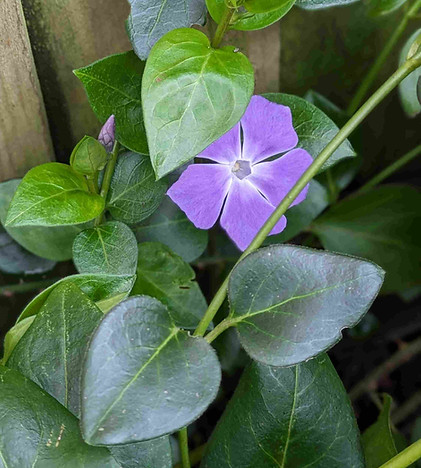
Greater periwinkle Vinca major - originating in Southern Europe, thriving in the shelter of a fence by a footpath

Chickweed Stellaria media one of our commonest annual weeds
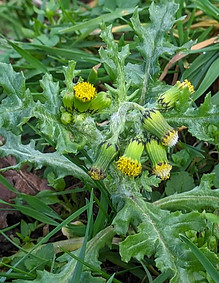
Groundsel Senecio vulgaris, another very common annual weed

Snowdrop Galanthus nivalis, a native of mainland Europe, here growing on Spring Cottage Green
Aliens!
A surprising number of the plants we find in the wild are non-native 'aliens', which mostly coexist perfectly well in wild communities alongside truly native plants, and many have been doing so for an extremely long time! An alien species is considered 'naturalised' when it has become self-perpetuating in the wild, and therefore not reliant on further introductions for its continued existence. An example is the snowdrop, a familiar spring flower coming into bloom in January and flowering until March. It has a long history in the UK as a garden flower, but was not recorded as growing wild here until the late 18th century. Since then it has certainly become naturalised from garden escapees, and white snowdrop 'valleys' can now be seen across the country.
Greater periwinkle is another alien species, but this is one which can be invasive - it can tolerate shade and poor soil to outcompete native plants and reduce species diversity. The plant is poisonous to cats, dogs and horses due to the toxic alkaloids it contains - these chemicals are components of the chemotherapy drugs vincristine and vinblastine, which bear its latin name as a result.
Weeds!
Many of the plants in flower at the moment are what the gardener would call 'weeds', opportunistic species which take advantage of the soil we disturb for them and then can be a nuisance so we try to get rid of them. In the past weeds were not things that needed to eradicated, but were seen as plants we could gather and use. The ethnobotanical term for this is a cryptocrop: a wild plant that is useful to have on the edge of your field and encouraged there, like chickweed to feed the hens, or bittercress with a taste like rocket to use in a salad, or red deadnettle and groundsel to use in herbal remedies.
Weeds are often great for pollinators - many are generalists, meaning they do not require specific insects to pollinate them but cater for many species, from bees and hoverflies to beetles and butterflies, with all their varying tongue lengths. They tend to have simple flowers and often grow in swathes; it is much easier for an insect to forage efficiently if it doesn’t have to fly far between food sources. Compared with many wildflower mixes, which tend to peak between June and August, weeds flower in cold and dull weather. At any point of the year, there is a weed in flower somewhere. Finally, they grow everywhere: in the shade, in the sun, on rubbish heaps, in the thickest clay or thinnest urban soils. You can buy wildflower seeds, but why not learn to love your weeds instead?
Plants that are considered truly native either arrived naturally in Britain and Ireland after the end of the last glaciation, transported by wind or animals (i.e. without the assistance of humans), or they were already present (i.e. persisted during the last Ice Age). The aliens have arrived here since then, the earliest arrivals accompanying humans migrating north as the ice retreated.
Nowadays, with ever increasing global trade and transport, the number of alien species in the UK exceeds the number of native species here! Sadly many of our native species are in decline, largely due to habitat loss but also due to competition with the few aliens which have proved to be invasive (like Himalayan Balsam or the pond weed Crassula, both of which we battle in Shamley Green). Of the 20 species pictured here, 8 are aliens - daffodils, crocus, hellebore, lungwort, periwinkle and cyclamen having arrived here since medieval times, and both species of deadnettle having arrived from Europe much earlier than that.